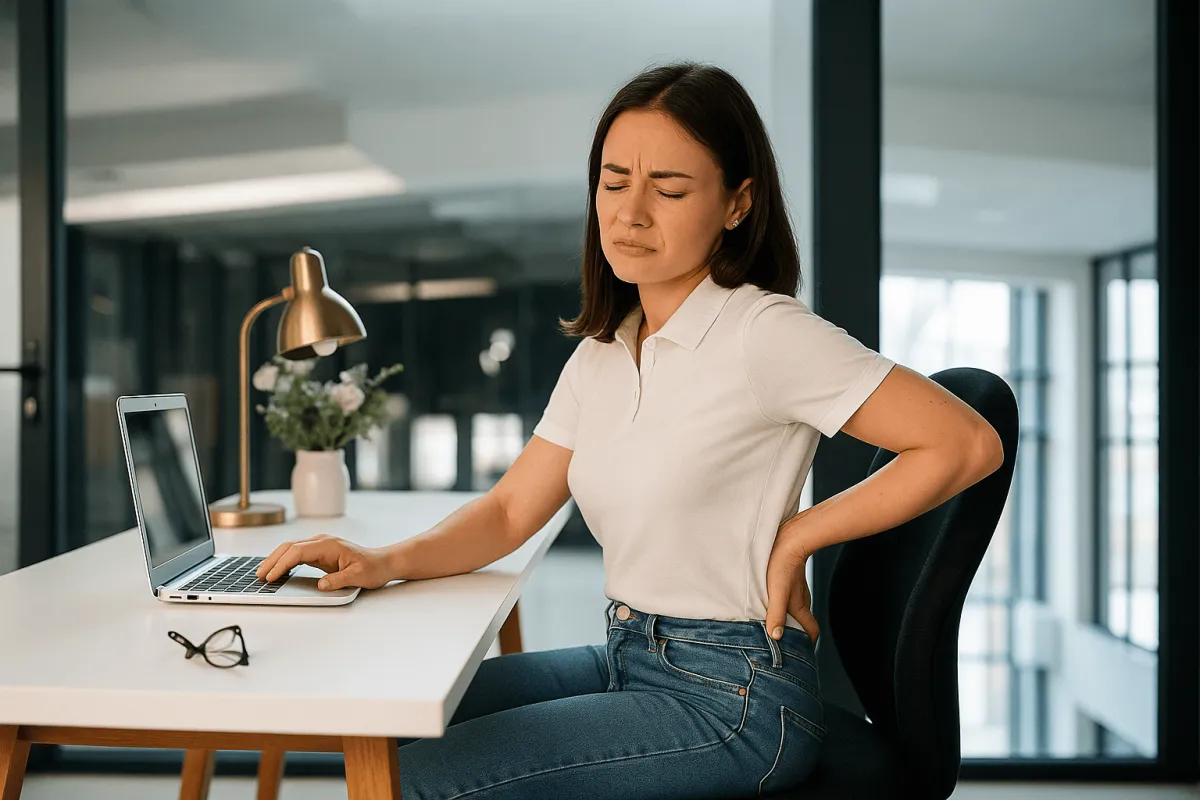
Sitting Too Much?—Surprisingly Simple Fix for Pain You Need to Know
If you’re like most people, you probably spend hours each day sitting—at your desk, in the car, on the couch. It’s such a normal part of modern life that we don’t even question it.
But here’s what might surprise you: sitting too much can damage your back.
I saw this again and again in my practice. Patients came in with nagging pain that no pill, massage, or even surgery seemed to solve. What they didn’t realize is that the simple act of prolonged sitting was tilting their pelvis, straining their joints, and firing up their nerves.
The good news? There’s a surprisingly simple fix.
Why Sitting Damages Your Back
When you sit for long periods, your body falls out of balance. Here’s what happens:
The pelvis tilts. Sitting pulls the top of the pelvis backward. This tilt spreads the sacroiliac joints (SI joints) slightly apart, stressing the ligaments that normally hold them tight.
Ligaments overstretch. When the pelvic bones are displaced, the ligaments trying to hold them together become overstretched. Over time, this stretching increases, allowing the pelvic bones to move ever further away from the sacrum and become even more displaced.
Muscles weaken or tighten. Core stabilizers go slack, while hip flexors and hamstrings tighten, pulling the pelvis further out of alignment.
Nerves get irritated. As the pelvis destabilizes, the nerves inside the overstretched ligaments become hypersensitive, sending sharp pain, tingling, or burning sensations into the back, buttocks, or legs.
Even if you think you’re sitting up straight, the very position itself is working against your body’s natural alignment.
Signs Sitting May Be Behind Your Pain
Not sure if sitting is your main culprit? Some clues include:
Pain that worsens after long meetings, driving, or flights
Relief when standing up and moving around
Stiffness in the hips or lower back when rising from a chair
A deep ache in the sacrum or buttocks after hours at a desk
If any of this sounds familiar, chances are, sitting is sabotaging your back.
Why Doctors Often Miss It
Most medical evaluations focus on structural problems: discs, bones, and arthritis. But sitting-induced pelvic instability doesn’t show up well on scans.
Unless someone takes the time to examine pelvic alignment and ask about your daily habits, the connection may be overlooked. That’s why so many people are told their pain is “nonspecific” or left without a clear plan—when in reality, the solution is often much simpler.
Practical Tips for Everyday Sitting
Beyond alignment, here are small shifts that make a big difference:
Set a timer: Stand and stretch every 45–60 minutes. Even two minutes of movement resets your pelvis.
Use a donut cushion: If you are sitting with your Sitz bones inside a donut cushion, they cannot spread apart. Since your Sitz bones are part of your pelvic bones, the cushion keeps your pelvic bones together and prevents them from moving out of place.
Realign the Pelvis: If you are hurting, do a lunge according to which of your pelvic bones is displaced and in what direction. Check my low back pain book for instructions. This two-minute stretch will put the joints back into place. Many patients felt immediate relief after just two minutes.
Check your posture. Sit with feet flat, knees slightly below hips, and shoulders relaxed.
Change positions. Alternate between sitting, standing, and walking throughout the day.
Upgrade your chair. If possible, use a chair that supports your lumbar spine and allows hip movement.
These micro-adjustments add up to major relief over time.
What About Relief Right Now?
Correcting alignment and building strength takes time. In the meantime, you need comfort. That’s why I often recommend QR Cream, a topical treatment I developed. It contains mannitol, a natural sugar compound that reduces nerve sensitivity right under the skin. Applied over sore areas, it can quiet pain quickly, giving you space to heal.
Why This Matters
Too many people live with back pain because they don’t realize how damaging prolonged sitting can be. They chase treatments that never quite work—when the real solution may be as simple as standing, stretching, and supporting their pelvis.
By addressing this overlooked cause, you can relieve pain, protect your joints, and reclaim the freedom to sit, stand, and move without fear.
Let’s Recap
✅ Sitting tilts the pelvis and strains SI ligaments
✅ Signs include stiffness, pain after sitting, or relief when standing
✅ Doctors often miss sitting-induced pelvic instability
✅ Fix it by realigning, supporting, and strengthening
✅ Simple lifestyle changes—plus QR Cream—bring relief now
Want to Learn More Ways to Relieve Back Pain Naturally?
🎥 Register for my free webinar: Live Without Pain
I’ll share natural ways to heal your body—without drugs or surgery.
For step-by-step guidance, you can also check out my book: “Low Back Pain: 3 Steps to Relief in 2 Minutes.”
Wishing you strength, comfort, and true healing,
— Hélène Bertrand, MD (retired)
CLICK HERE TO RECEIVE LOW BACK PAIN RELIEF in 2 MINUTES!
Disclaimer: This content is for informational and educational purposes only and does not substitute professional medical advice, diagnosis, or treatment. Always consult your healthcare provider before starting any new treatment or making changes to your health regimen. Although Dr. Bertrand is a retired medical doctor, she is not practicing medicine or providing medical care through this website.
